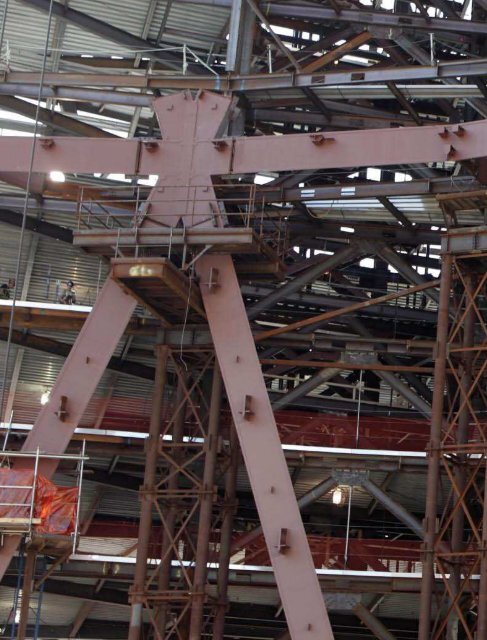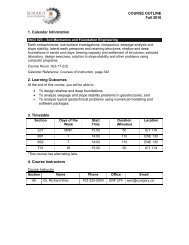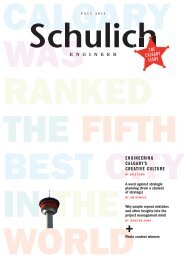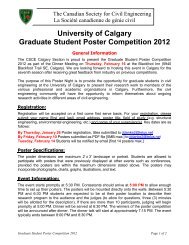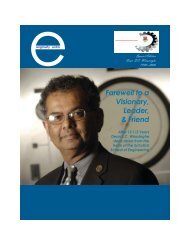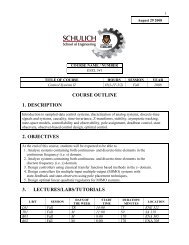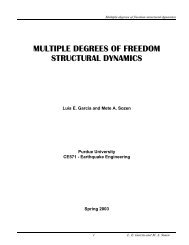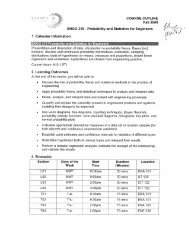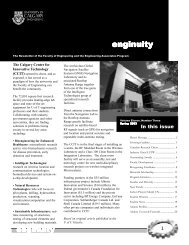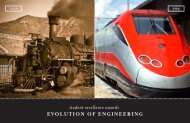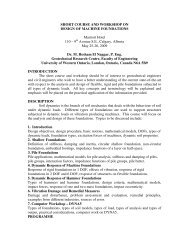high performance - The Schulich School of Engineering - University ...
high performance - The Schulich School of Engineering - University ...
high performance - The Schulich School of Engineering - University ...
- No tags were found...
You also want an ePaper? Increase the reach of your titles
YUMPU automatically turns print PDFs into web optimized ePapers that Google loves.
STRUCTURESTHAT OUTPERFORMBY J E N N I F E R S O W ABENDING, SQUEEZING, STRETCHING, FREEZING: PUSHINGMATERIALS TO THEIR LIMITS IS NOW REQUIRED TO DEVELOPMODERN STRUCTURES AND PRESERVE OLD ONES.Australia’s southernmost state ishome to a 50-metre sandstonebridge nearly two centuries old that is abit <strong>of</strong> an engineering marvel in this littlecorner <strong>of</strong> the world.<strong>The</strong> Ross Bridge was constructed overthe Macquarie River in the 1830s whenthe island state <strong>of</strong> Tasmania was a penalcolony for British criminals. Convictswere put to work building the bridge andsome <strong>of</strong> them happened to be talentedartists and stonemasons. <strong>The</strong> result was astructurally impressive bridge decoratedwith dozens <strong>of</strong> intricate carvings <strong>of</strong>symbols, flowers and human faces.Two prisoners actually received pardonsbecause <strong>of</strong> their extraordinary work.<strong>The</strong> Ross Bridge supports vehicular trafficto this day and has become known as“the finest masonry bridge <strong>of</strong> its time,”according to the Australian HeritageDatabase.“We are very proud <strong>of</strong> the Ross Bridgeas an outstanding and unique example<strong>of</strong> early colonial infrastructure thatcontinues to be used to the presentday,” says Pete Smith, director <strong>of</strong>Heritage Tasmania.It was a bridge built to last. But while itshistory makes it unique, the Ross Bridgehas one trait in common with countlessother structures: it’s at the mercy <strong>of</strong>the elements. Weathering is erasing thetreasured carvings like drawings on achalkboard. Many experts fear all the finedetail will be gone in 25 years.It won’t be lost forever, though, because<strong>of</strong> modern engineering technology.Four years ago, specialists in threedimensionallaser scanning mappedthe Ross Bridge. Derek Lichti, a formerpr<strong>of</strong>essor at Curtin <strong>University</strong> <strong>of</strong>Technology in Perth, Australia, andhis graduate student developed newcomputer algorithms to take informationfrom the digital scans to form acomplete, detailed image <strong>of</strong> the bridge.One day, that data will provide crucialguidance for the experts who restoreand preserve the bridge and its artwork.“<strong>The</strong> scans give you the precise geometry<strong>of</strong> the bridge,” explains Lichti, who is nowbased in the geomatics department at the<strong>Schulich</strong> <strong>School</strong> <strong>of</strong> <strong>Engineering</strong>. “Whenyou consider additional informationsuch as the material, in this case it’ssandstone, you can figure out thestructure’s strength properties.” >>Photo by David MollSCHULICH21ENGINEER


